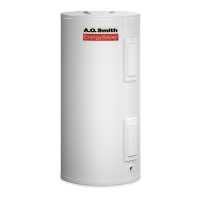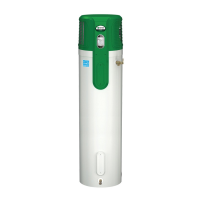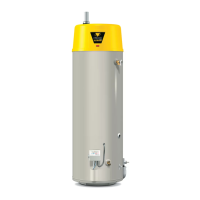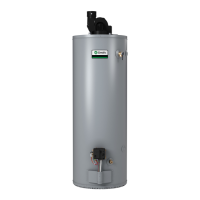2.2.4 Temperature control
The apparatus is under the pressure of the water supply
(max. 8 bar). There will be supplied the same quantity of
cold water as the one used up of hot water. This implies
that in the moment of showing the thermostat a temperature
being inferior to the set one, the electric circuit will be
closed, making an electric current pass through the heating
element. After having reached the demanded temperature,
the thermostat will interrupt the contact again. High water
temperature will involve a calcium precipitation, inside
the heater. Therefore, it is recommended to maintain the
adjusted temperature of 60 °C, so that less furring will occur.
Moreover, a built in safety thermostat will completely
interrupt the current supply, at a water temperature of 95 °C.
2.3 Maintenance
At least once a year, the heater will have to be checked
and cleaned by an expert, to guarantee its good function.
2.3.1 Sacricialanode
The service life of the anodes is determined by the quality
andquantityofthewaterowingthrough.Thatiswhyiet
will be recommendable to have the anodes inspected,
every year.
I. Turn off the cut-off cock of the feed pipe of cold water.
2. Open the nearest warm water tap, to eliminate the
water pressure of the heater and the water conduit.
3. Loosen the anode by the right key.
4. Inspect and replace it, whenever used off by 60%.
5. Screw in the anode to be waterproof.
If the anode must by replaced, make sure that the new
one always will be of exactly the same type. This can
be checked by the type of the heater, as well as by the
complete serial number.
2.3.2 Decalcication
The lyme forming is a sequel of the quality and the
dmand of the water. Besides, lyme forming will always
be of a higher degree with high water temperatures than
with low ones. Therefore, it is recommended to adjust
the temperature at 60 °C, so that the degree of calcium
precipitation can be kept at a low rate. Decalcification will
have to be done by using appropriate means. If you need
more detailed information thereon, the relevant instructions
are available.
2.4 Measures to be taken at moments
of failures
Whenever there is a failure, the items given below will
have to be checked before calling a trouble-shooting
service.
2.2 Putting into operation
2.2.1 Filling of the heater
1. Install the drain tap and check whether it is closed.
2. Open the cold water tap leading to the heater and the
rest of the taps of warm water outlet, for ventilation.
Theapparatuswillbelled,assoonaswateris
owingoutofeveryoutlet.
3. Again, turn off all the taps of warm water outlets.
2.2.2 Putting into operation
1. Check,whethertheheaterislledwithwaterand
whether all electric connections leading to it are
actually well carried out.
2. Check whether the cold water inlet is open.
3. Open the covering plate at the front remove the
insulation to be found thereunder. Now, the regulating
thermostats will be accessible. And can subsequently
be adjusted at the demanded temperature, by turning
the selector switch by a screwdriver.
4. Set the demanded temperature, on the regulating
thermostat (see table). The temperature adjusted ex
works is of 60°C.
Temperature in °F Temperature in °C
90 32
100 38
110 43
120 49
130 54
140 60
150 66
5. Replace the insulation and put back the covering plate.
6. Withaxedconnection,switchonthemainswitch
or, otherwise, put the plug into the socket. Thereon,
the apparatus will be in operation and start to work,
automatically.
2.2.3 Puttin out of operation
1. For short periods: Remove the plug from the sockey or,
iftheconnectionisxed,switchoffthemainswitch.
2. For longer periods, it will be recommendable to not
only act according to the advises sub 1, but also
shut of the water supply pipe and, as soon as the
heaterwillbecooledoff,letoutthewater(ttingan
outlet pipe on the drain tap and open it), in view of
the danger of frost. (Open the nearest warm water
drain taps, as well, so that the tank can be ventilated).
Whenever the heater will have to be emptied
completely, detach it and let it slope in the direction of
the drain tap.

